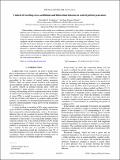| dc.contributor.author | Landsman, Alexandra S. | |
| dc.contributor.author | Slotine, Jean-Jacques E. | |
| dc.date.accessioned | 2013-01-08T17:50:55Z | |
| dc.date.available | 2013-01-08T17:50:55Z | |
| dc.date.issued | 2012-10 | |
| dc.date.submitted | 2012-05 | |
| dc.identifier.issn | 1539-3755 | |
| dc.identifier.issn | 1550-2376 | |
| dc.identifier.uri | http://hdl.handle.net/1721.1/76203 | |
| dc.description.abstract | Understanding synchronous and traveling-wave oscillations, particularly as they relate to transitions between different types of behavior, is a central problem in modeling biological systems. Here, we address this problem in the context of central pattern generators (CPGs). We use contraction theory to establish the global stability of a traveling-wave or synchronous oscillation, determined by the type of coupling. This opens the door to better design of coupling architectures to create the desired type of stable oscillations. We then use coupling that is both amplitude and phase dependent to create either globally stable synchronous or traveling-wave solutions. Using the CPG motor neuron network of a leech as an example, we show that while both traveling and synchronous oscillations can be achieved by several types of coupling, the transition between different types of behavior is dictated by a specific coupling architecture. In particular, it is only the “repulsive” but not the commonly used phase or rotational coupling that can explain the transition to high-frequency synchronous oscillations that have been observed in the heartbeat pattern generator of a leech. This shows that the overall dynamics of a CPG can be highly sensitive to the type of coupling used, even for coupling architectures that are widely believed to produce the same qualitative behavior. | en_US |
| dc.language.iso | en_US | |
| dc.publisher | American Physical Society | en_US |
| dc.relation.isversionof | http://dx.doi.org/10.1103/PhysRevE.86.041914 | en_US |
| dc.rights | Article is made available in accordance with the publisher's policy and may be subject to US copyright law. Please refer to the publisher's site for terms of use. | en_US |
| dc.source | APS | en_US |
| dc.title | Control of traveling-wave oscillations and bifurcation behavior in central pattern generators | en_US |
| dc.type | Article | en_US |
| dc.identifier.citation | Landsman, Alexandra, and Jean-Jacques Slotine. “Control of Traveling-wave Oscillations and Bifurcation Behavior in Central Pattern Generators.” Physical Review E 86.4 (2012). © 2012 American Physical Society | en_US |
| dc.contributor.department | Massachusetts Institute of Technology. Department of Mechanical Engineering | en_US |
| dc.contributor.mitauthor | Slotine, Jean-Jacques E. | |
| dc.relation.journal | Physical Review E | en_US |
| dc.eprint.version | Final published version | en_US |
| dc.type.uri | http://purl.org/eprint/type/JournalArticle | en_US |
| eprint.status | http://purl.org/eprint/status/PeerReviewed | en_US |
| dspace.orderedauthors | Landsman, Alexandra; Slotine, Jean-Jacques | en |
| dc.identifier.orcid | https://orcid.org/0000-0002-7161-7812 | |
| mit.license | PUBLISHER_POLICY | en_US |
| mit.metadata.status | Complete | |
